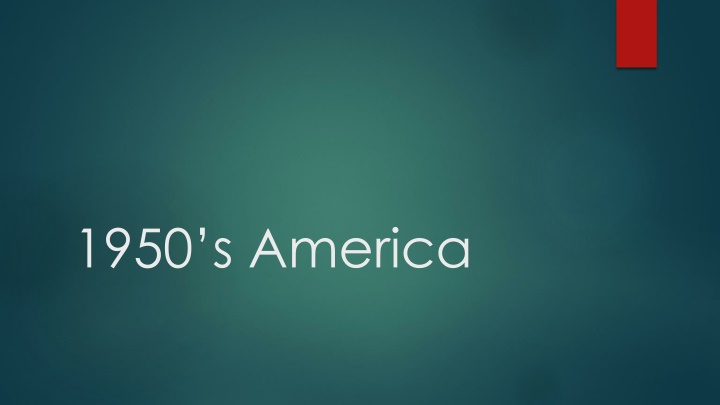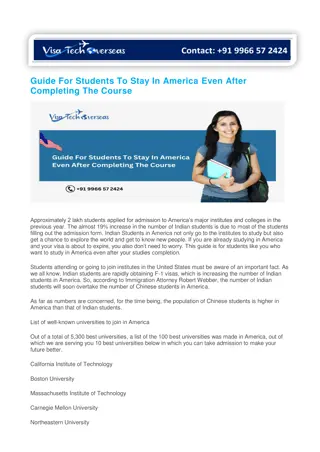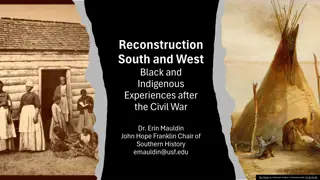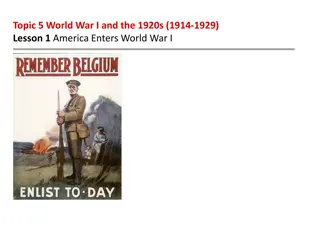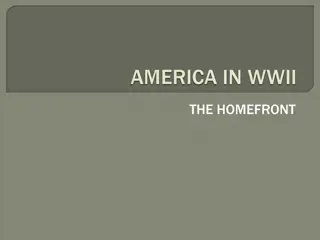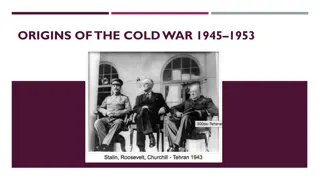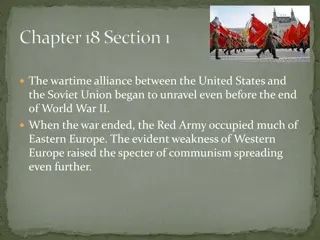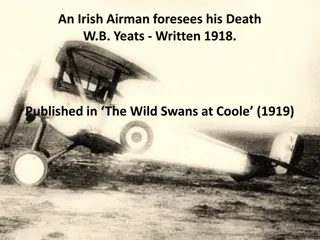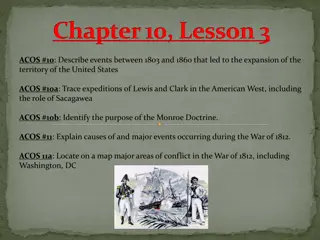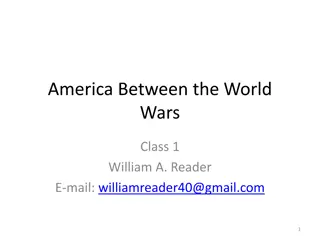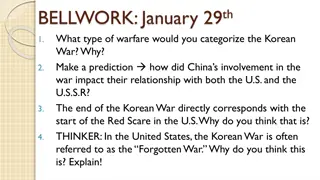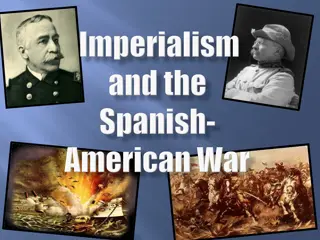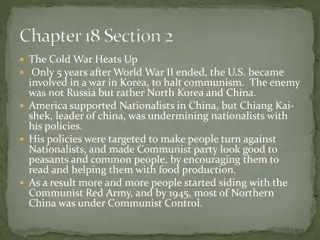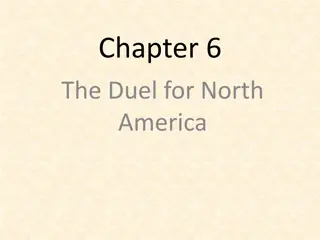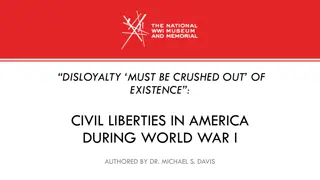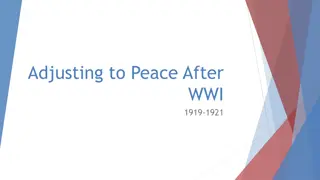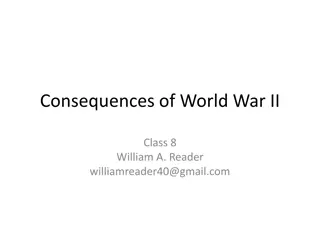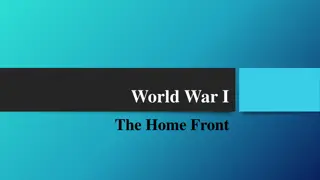Post-War America: Challenges and Changes
Following the end of World War II, the United States faced a period of transition with significant challenges and societal changes. Returning veterans, economic shifts, GI Bill benefits, family life transformation, women's evolving roles, and political uncertainties marked this era.
Download Presentation

Please find below an Image/Link to download the presentation.
The content on the website is provided AS IS for your information and personal use only. It may not be sold, licensed, or shared on other websites without obtaining consent from the author.If you encounter any issues during the download, it is possible that the publisher has removed the file from their server.
You are allowed to download the files provided on this website for personal or commercial use, subject to the condition that they are used lawfully. All files are the property of their respective owners.
The content on the website is provided AS IS for your information and personal use only. It may not be sold, licensed, or shared on other websites without obtaining consent from the author.
E N D
Presentation Transcript
Thats a lot of People 10 Million men and women were coming home after being released from the armed forces. This is going to create a numbers crunch Why is there going to be a problem?
Money, Where is It? $35 Billion dollars of government contracts were cancelled because of the ending of the war. 3 million people were out of work Regulation of inflation ended so the prices started to rise Up 25% What s going to happen?
Money, Money, Money, Money People had money to spend and they did just that Bought everything they could get their hands on Cold War also helped the economy with the mass production of war materials What does this lead to?
GI Bill 1944, Bill was made to help returning Veterans get adjusted to civilian life Gave benefits for veterans to get and education A years worth of unemployment And low-interest on loans
Family life 1945-46 there was a housing shortage Large amount of people moved from the cities to the suburbs. William Levitt revolutionized the way homes were being built The houses were cheap Fast to make
Im Not Boing Back in the Kitchen During the war women were asked to give up their traditional role as the house keeper and enter the work force Post War, what would be the problems? Tension in the household led to divorce 1/5 of women were unhappy with there lives 40 percent of mothers with children 6-17 had paying jobs
New President New Problems Truman was very inexperienced and with the Post War problems there were doubts he would be able to withstand that Unions started to strike Truman shuts it down Republicans push for Truman to not be reelected but fail Why was he reelected?
Ahead of the Times Truman led the way in Civil rights No discrimination in a government work place Laws that barred not allowing African Americans from moving into a residential neighborhood
The Fair Deal Extension on FDR s New deal Nationwide healthcare Crop-subsidy Raise minimum wage 10 million more people received social security Build up low income housing Despite that come 1952 who becomes president?
Business was changing With more people going to College more people too were starting to move away from building things and into the office Big Business is the future
Business Conglomerates ITT American Telephone and Telegraph Xerox General Electric Why did businesses move to become Conglomerates
Franchises and Social Conformity Businesses like McDonalds, Dunkin Donuts and KFC started to pop up everywhere. Faster is better This process mirrored society
Population Growth The 1950 s saw the Population of the Unites States growth Birthrate sky rockets Advancement in modern medicine Polio is cured 1950
Wheres the Fun? People had a lot more time to do things because of inventions that saved time. Need to fill that time with leisure activities Sports became a huge outlet for children and adults. Football and baseball were broadcasted on T.V. and stadiums were packed
Hitting the Open Road The production of cars and the large sum of oil led to the car boom 60 million more cars were on the road once the 50 s ended. That was 20 million more cars than were on the road in 1950 The development of the interstate highway Not everything was perfect
Capitalism at its Finest Consumerism was a new term that was used to describe the spending habits of your average American People were buying new home appliances that made their lives easier The Credit Card is introduced
Capitalism Continued Planned Obsolescence was introduced to America Every year car companies would come out with a new car Be the most up-to-date Installment Plans for goods Advertisers spent billions to make sure they had the consumers attention
They Will Find You Mass media- means of communication that reach large audiences T.V. was by far the largest of all the different types of media By 1960, 90% of Americans had a T.V. in their homes People received their news, entertainment and advertising from the television
Playing the Stereo Type T.V. did their part in stereo typing people and putting them into their traditional roles in society Women were your perfect mothers Men were the leaders of the house and new what was best all the time Biggest part of society that was missing was minorities If they were shown in a show they were not of great importance Did not show the poverty side of the nation that made up 25% of the population
Radio is for the Lower Class With the development of T.V. many though Radio would die Radio stations moved to news, weather, music and community issues Advertisers used radio to target the low income families that could not afford T.V. s
RocknRoll Many of the musicians were African American while the people listening were White Songs featured things about love, cars, and the problems facing young America. Elvis Presley, The King of Rock n Roll bursts onto the scene
Racial Divide Rock N Roll was a start to change There voices were being heard Set the stage for change
Poverty, the Hidden Problem 1962 25% of Americans were living below the poverty line Minority groups made up a large portion of that Urban Crisis, what was it? Urban Renewal- was enacted to make sure that everyone had a suitable living environment to live in
Mexican Seeking Employment 1942, program is formed where Mexican hired hands came in and helped harvest the crops. Once they were no longer needed they were sent home Sound Familiar???
Native Americans 65,000 Native Americans helped out in the War. They came home to part of their land being taken Termination Policy Eliminated federal support for the Native Americans Relocated Native Americans to the cities Lasted only 10 years
